Summary:
- OODA Loop is a four step process that is constantly happening and driving all decision making
- Observe – intake information from your environment
- Orient – process information
- Decide – decide on what you need to do
- Act – take the action to make your changes in the environment
WAR
The OODA Loop is a decision-making process developed by a US Air Force fighter pilot named Colonel John Boyd.
OODA stands for (Boyd, 1):
- Observe
- Orient (Think)
- Decide (Hypothesis)
- Act (Test)
The four steps of the process are a sequential cycle that happens whether or not you’re conscious of it. You are constantly observing your environment, orienting on what you see, deciding on what to do and then acting on that decision.
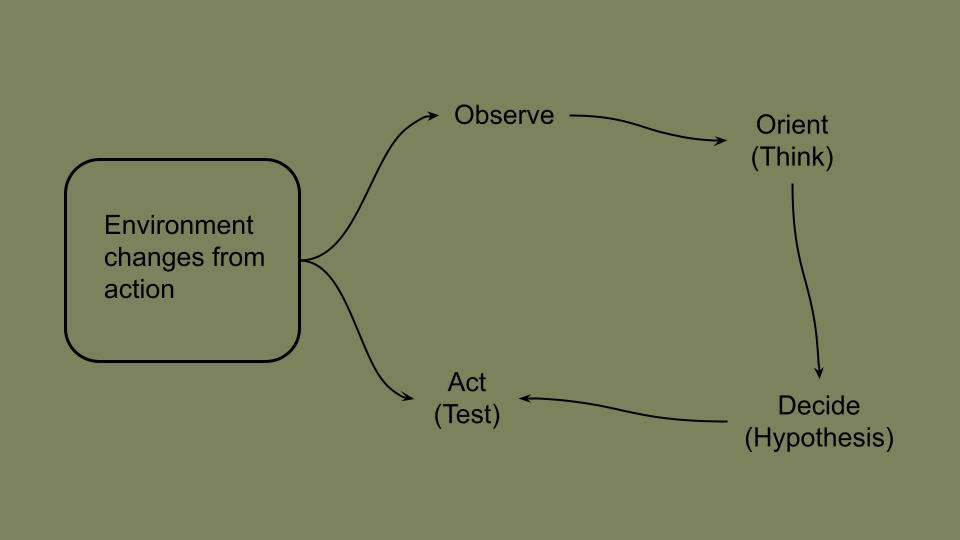
The faster, more accurate, and bolder your OODA Loop is, the greater the advantage you will have on your opponent. The advantage comes from your actions causing a change in the environment. These changes will force your enemy to either reset their OODA Loop or take action without considering it. If they reset their OODA Loop, their decision-making is slowed. If they have to take action without considering it, their decision will be less accurate.
“Idea of fast transients suggests that, in order to win, we should operate at a faster tempo or rhythm than our adversaries—or, better yet, get inside the adversary’s observation-orientation-decision-action time cycle or loop. Why? Such activity will make us appear ambiguous (unpredictable) thereby generating confusion and disorder among our adversaries—since our adversaries will be unable to generate mental images or pictures that agree with the menacing as well as faster transient rhythm or patterns they are competing against.” (Boyd, 1)
If you are taking more action to change the competitive environment than your competition, you will have the initiative and a competitive advantage.
Observe
Observation is the first step. All current context and information is gathered during this step.
The inputs that Col Boyd outlined for observation are:
- Unfolding circumstances
- Outside information
- Unfolding interaction within the environment
- Implicit Guidance and Control
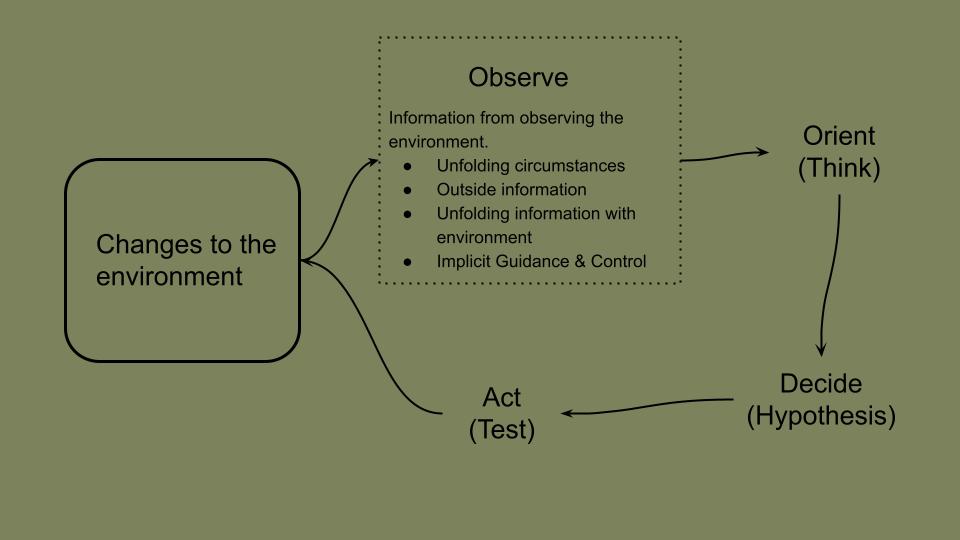
There are an unlimited amount of things that you can observe. Choosing the right things is the main contributor to making good decisions. There are certain observations which do not help you make your next decision. There is also valuable observation which is closely monitoring the exact thing that will help to drive your next best decision.
There are constant changes in your environment. You, your opponent and other factors are contributing to the changes. Most of them are not within your control.
Actively monitoring the changes and seeking relevant information is the best way to increase the accuracy of your decision making. The only way you know what to look for, is through thorough analysis and previous experience.
Here is an example:
Imagine there are two fighter pilots in a dog fight. The communist fighter has an older, confusing control panel on his plane. This causes him to look down to flip switches, which breaks his observation of his enemy. The American F-22 fighter pilot has read War and Business blog posts and keeps constant observation on his opponent. Every time the communist jet makes a move, he counters immediately with a move of his joystick. The American slowly gains position, since his observation is laser-focused on the exact information he needs to make his next best decision. He eventually takes his six. He’s got a tone. The Hellfire missile is out and the enemy is destroyed.
The person who is more closely observing the more relevant information to make their next best directions, will speed up your OODA Loop. This gives them an advantage over their enemy driving accurate decisions and decisive action.
Key takeaway: Know exactly what information you need to make the next decision and actively observe for that information.
Orient (Thinking)
The orientation step is the least intuitive. Consider it the ‘thinking’ step.
Google defines orient as “ to adjust or tailor (something) to specified circumstances or needs.”
In this step, you will use your prior experience, intelligence and knowledge to process your observations to help you to generate a decision.
The inputs that Col. Boyd outlined for orient are:
- Cultural traditions
- How have you and your enemy been socialized to approach this decision?
- Genetic heritage
- How physically and mentally capable are you, compared to your enemy?
- Are your pre-dispositions an advantage or disadvantage? (exp. risk taker vs. not a risk taker)
- Analysis and synthesis
- How hard have you thought and processed the possible outcomes involved in this decision?
- New information
- Have you analyzed and synthesized all new and relevant information or have you ignored or not paid attention to it?
- Previous experience
- How much experience do you have with similar decisions?
The orient step is an aggregate of your capabilities, experience, disposition and level of analysis of the decision. All of these things will determine how well you can predict the outcome of your decision and following action. The more accurately you are able to predict the outcome of your actions, the more likely you are to make the best decision.
Another example:
If a pilot just finished Top Gun training, they would destroy a brand new pilot in a dog fight. This is because their orientation is going to be much more advanced. The action they decide to take will be more accurate and decisive than a beginner. Their experience and advanced training would have allowed them to analyze and synthesize the environment faster, while also constantly observing and processing new information.
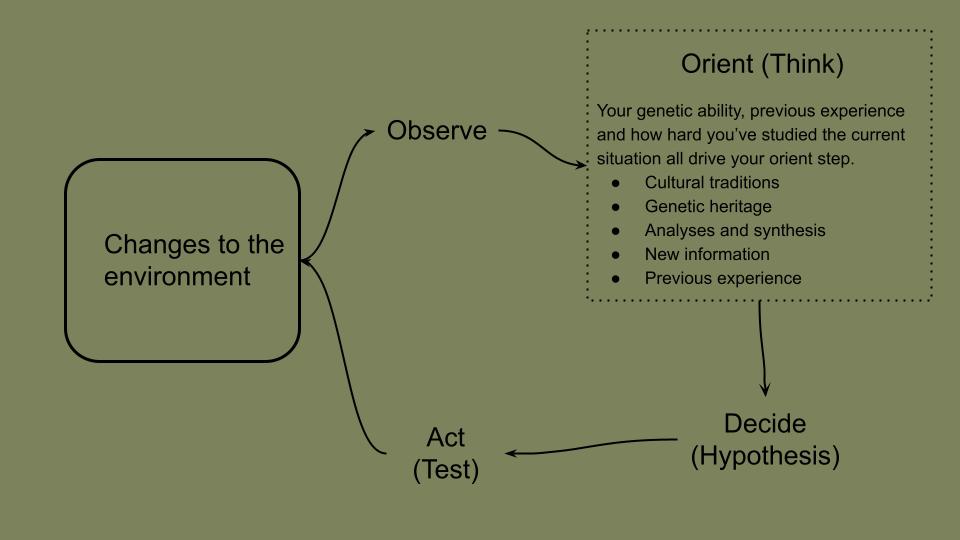
There are a few key considerations about the orient step.
First, of the inputs that Col. Boyd outlined, only ‘analyses and synthesis’ and ‘new information’ can be immediately impacted. If you’ve done a deeper analysis of the situation, and have monitored all the new information more closely, you can have an advantage over a more experienced or more genetically gifted competitor.
Second, you can develop your orient step by building the correct type of experience and considering what types of cultural and genetic advantages you have. As you build experience in a field, your decision-making will become faster and more accurate.
Key takeaways: The orient step is an aggregation of how capable and knowledgeable you are at understanding the current situation. This is driven by information from the observation step and will feed what decision and action you take.
Decide (Hypothesis)
The thinking is done and it’s time to decide.
Col Boyd also referred to this step as a ‘hypothesis’. Google defines “hypothesis” as “a supposition or proposed explanation made on the basis of limited evidence as a starting point for further investigation.”
It defines “decide” as “to come to a resolution in the mind as a result of consideration.”
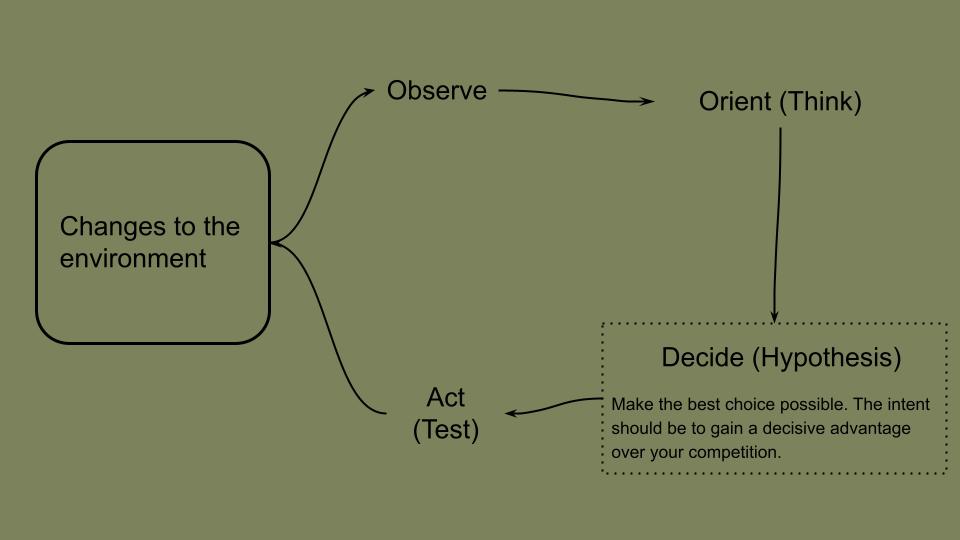
What are the implications of using decide vs. hypothesize?
Hypothesizing vs. deciding are on the opposite sides of a spectrum. The difference is the level of resource commitment during the action. On the hypothesized side of the spectrum, you can learn by making small decisions and assessing the impact. On the deciding side of the spectrum, are bold decisions in which large amounts of resources are committed that will cause more change in the environment.
When you are less experienced (your orientation step is less developed) taking an investigative approach to your decision-making is beneficial. This allows you to make smaller, faster decisions and increase the pace of your OODA Loop. The risk in making small decisions is they may not decisively impact your enemy’s OODA Loop. If the change is too small, then they may ignore your action and move forward causing them to get the upper hand.
If you’re more experienced, you can take bolder and more decisive action to gain an upper hand more quickly.
I put together the quadrant graph below with a horizontal axis of ‘decision accuracy’ and a vertical axis of ‘decision boldness’.
- Top Right: Where you want to be is in the top right – bold and accurate. This is where someone with considerable experience and a deep understanding of the situation can make a decisive decision and take bold action to get an upper hand.
- Bottom Right: The bottom right is a little more experimental – less bold but still accurate. This type of action allows you to invest fewer resources, while still learning and improving your position. If you’re less experienced or not as familiar with the situation, then it’s probably where you want to be with your decision making.
- Bottom Left: The bottom left is still generally positive – less bold and not accurate. In this case, you took less risk by making a less decisive decision and took smaller action. Even though you were wrong in your decision and lost your position, you didn’t invest as many resources. This allowed you to learn, without getting too far out of position.
- Top Left: The top left is where you don’t want to be – bold and not accurate. This means you swung for the fences and missed badly. You end up expending a lot of resources and getting way out of position. As a result, your competition gains a lot of ground on you. This is a place where overly confident and inexperienced people get themselves.
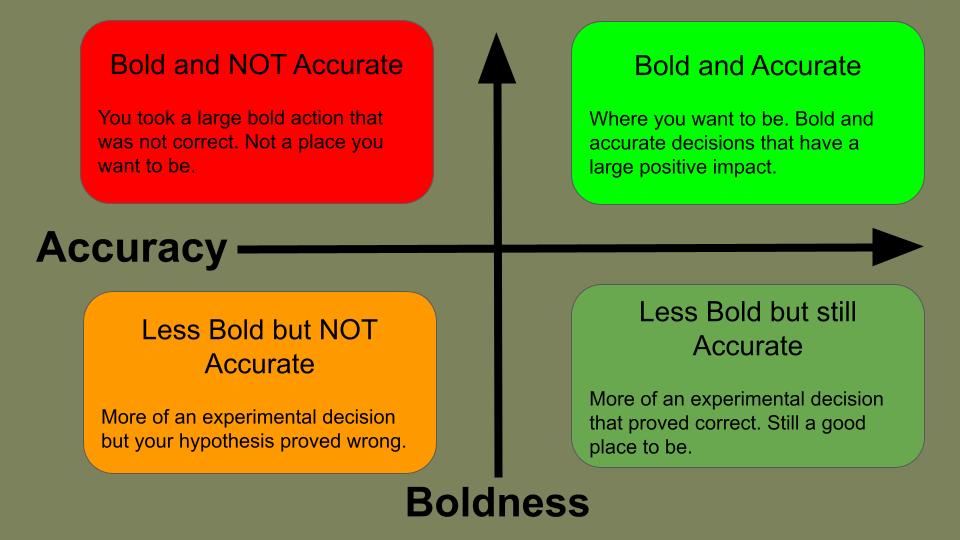
Someone with more experience will read the environment faster and more accurately. This allows them to make bold decisions and gain an advantage. Making rapid, accurate decisive decisions is heavily dependent on how developed your orientation is.
There will also be times that you will have come to the end of hypotheses and there is a clear path forward. Once it’s clear what is working, a heavy commitment to a decision is needed to make significant impacts.
Key takeaways: You want to make bold, accurate decisions. To do that, you need a highly developed orientation. If you don’t, you should make less decisive decisions to learn and expend fewer resources, until enough assumptions have been confirmed to set conditions for a bold decision.
Act (Test)
After the decision, there is a follow-on action to implement it.
Action is defined as “the fact or process of doing something, typically to achieve an aim.”
The key concept of the OODA Loop is understanding that the more and faster your actions change the competitive environment, the more your enemy will have to reconsider their current decisions. This will cause them to cycle back through while you have moved on to the next action, which then causes more disturbance.
The intent of your action should always be to change the environment your enemy is observing.
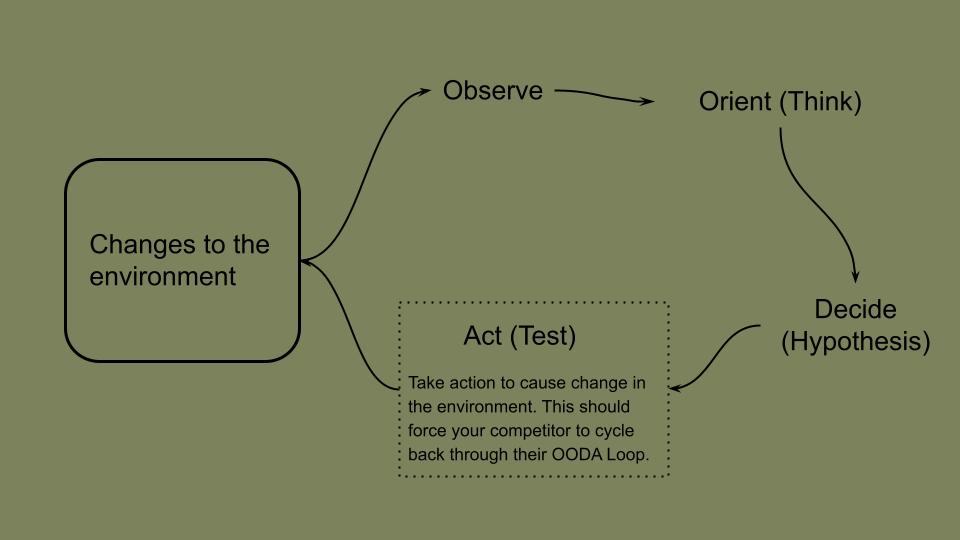
If you are less experienced or less familiar with the situation (your orientation is less developed), taking the smallest action that you can that still has an impact on your enemy allowing you to learn is the action you should take. Once a clear pattern of advantage has been established, bold action should be taken to win the engagement.
If you are very experienced or have a deep understanding of the situation, then bold action should be taken to gain as much ground as possible. The key is to make accurate predictions of the future outcome.
A key concept of the OODA Loop is outpacing your enemy. If you’re consistently taking action ahead of their loop, you’ve got the initiative. To do this, you need to take action and keenly observe how your enemy responds, so you can take advantage of the initiative you created.
If you give them too much time to reset their OODA Loop, you’ve lost the initiative.
Key takeaways: Your actions are the only real things that happen. They need to impact the environment to force your enemy to observe and process new information, or ignore it and lose ground.
Even vs Uneven Loops
The following are some examples of even competitors and uneven competitors.
Below is a diagram that shows even OODA Loops.
- In this situation, the competitors are taking evenly paced action
- No distinct advantage has been established
- They are observing at the same level of keenness, their orientations are evenly developed, they are taking similarly accurate and decisive decisions, which causes their actions to be of a similar level of boldness.
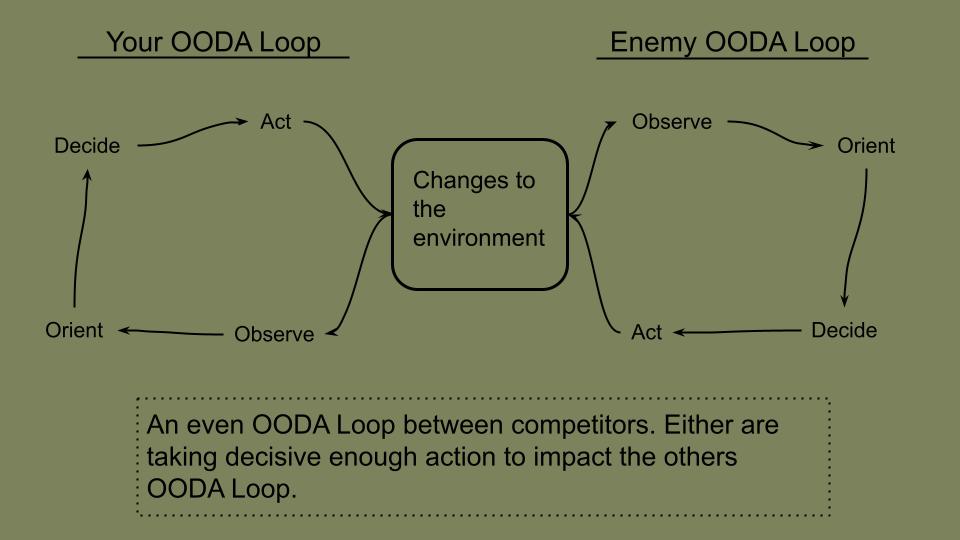
The following is a diagram that shows uneven OODA Loops.
- In this situation, the competitor on the left has a smaller loop. Their Decide and Act are much larger, representing bolder decisions and actions. Their Observe and Orient is smaller, representing rapid observation and thinking
- The loop on the right is much larger. This is because they are behind in their action compared to their competitors. They have a long Observation and Orient step, causing them to take smaller and less bold actions.
- The loop on the left has a clear decision making initiative.
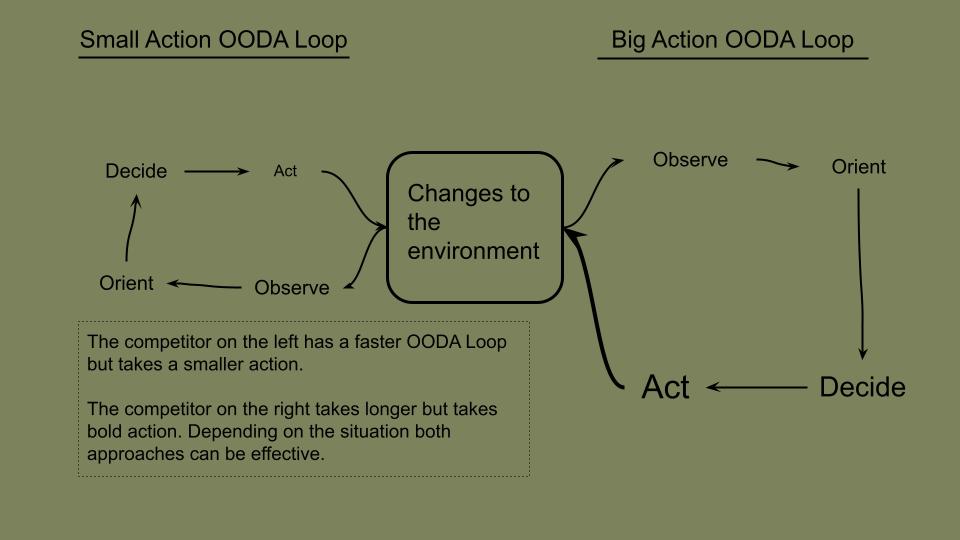
When someone is “one step ahead” of their competition, they are out pacing their OODA loop.
In a fairly even competition, who is ahead in decision making will alternate. One competitor may ignore the changes while they take a bold action. This bold action will then impact the other competitor, forcing them to reset their OODA Loop and lose the decision making initiative.
It is a constant struggle to gain and maintain the decision making initiative.
Key takeaways: If you are watching a competition closely, you can see when the competitors are trading decision making initiatives. As changes are being made to the environment, time has to be spent observing, orienting, deciding and acting. Being one step ahead is always the goal.
Boyd’s OODA Loop Diagram
John Boyd’s full OODA Loop diagram is shown below.. The previous images were created to clarify and simplify specific parts. Now that you have read through this entire article, the full image is helpful to read through and start analyzing on your own.
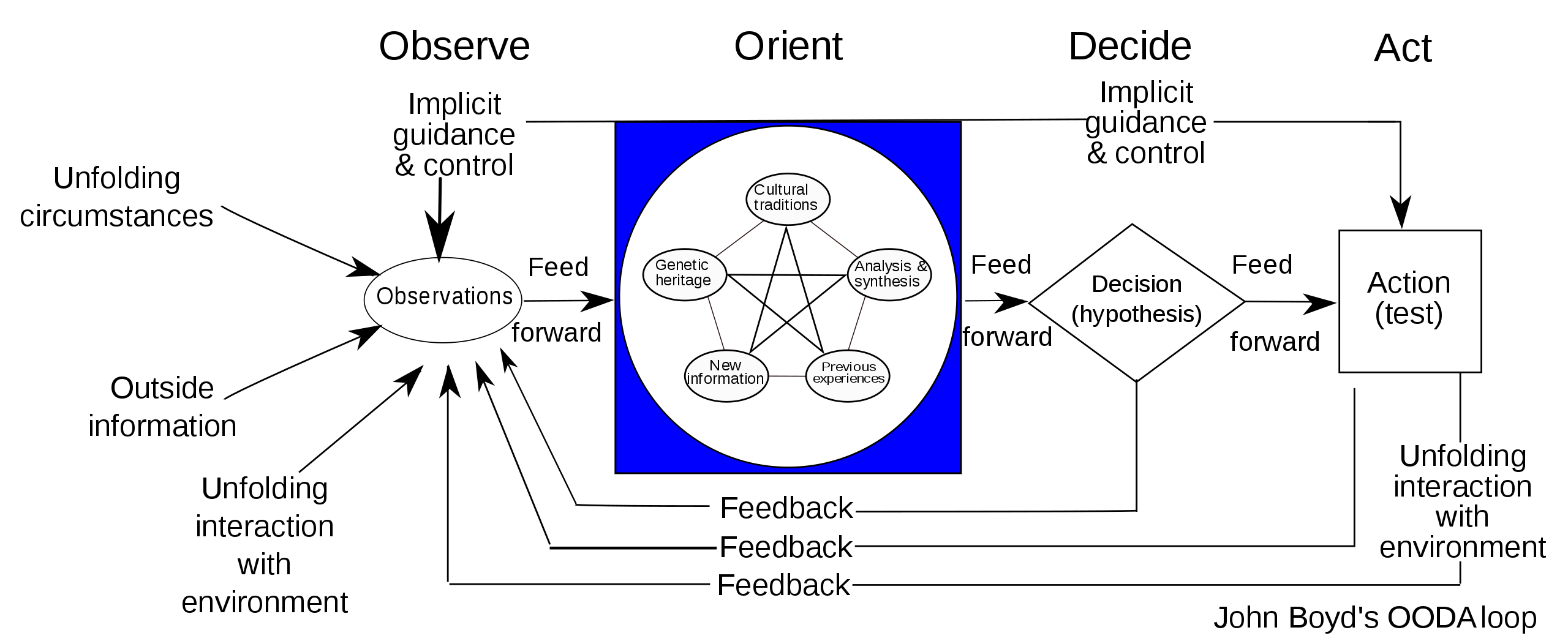
Full OODA Loop, Wikipedia (2)
Now we’ll consider how the OODA Loop can be applied to the business world.
The next section will consider how the OODA Loop can be applied to the business world.
BUSINESS
In the business world, your OODA loop is always spinning.
It is spinning in your interactions with your boss, your colleagues, your subordinates and your customers. Some interactions will cause it to spin more because those interactions are important. If you’re trying to close a big sale or debug some code, your OODA Loop is spinning hard and fast on the current problem.
How do you improve it to make faster, more accurate, bolder decisions that lead to decisive action?
The following are some general thoughts about how each step that can lead to improvement:
- Observe
- We need to know exactly what information is needed to make the next decision and pay very close attention to the environment to gather it.
- That may mean watching your competitors very closely to see what new products or services they are introducing into the market. It also may mean watching how your boss or colleagues respond to the proposal you gave them.
- The key concept is that you need to keenly observe, so that you can then orient on any new information.
- We need to know exactly what information is needed to make the next decision and pay very close attention to the environment to gather it.
- Orient
- Think as hard as time allows, before taking action. It is important to get input from as many experienced people as possible.
- The three inputs over which we have most control in the orient step are:
- Analysis and synthesis – How hard have you thought and processed the possible outcomes involved in this decision? Have you considered all of the different ways this could go? Do you have contingency plans for all of the possibilities? Have you talked to anyone who has dealt with a similar situation?
- The deep analysis will help to develop your orientation for this situation. Even if none of the worst case scenarios develop, the effort you put into the analysis is important.
- New information – Have you analyzed and synthesized all new and relevant information or have you ignored or not paid attention to it? This is linked very closely with ‘observe’. First, are you actually paying attention? Second, are you actually thinking about what that new information is telling you?
- The person who is paying the closest attention and putting that information to the best use will have the edge.
- Previous experience – how much experience do you have with situations like this? If you don’t have very much, then you need to seek advice from a mentor or advisor. You also need to be taking deliberate action to get the experience. You can do that through reading, courses or from taking on small or similar projects. None of us have too much experience or education.
- Analysis and synthesis – How hard have you thought and processed the possible outcomes involved in this decision? Have you considered all of the different ways this could go? Do you have contingency plans for all of the possibilities? Have you talked to anyone who has dealt with a similar situation?
- The three inputs over which we have most control in the orient step are:
- Think as hard as time allows, before taking action. It is important to get input from as many experienced people as possible.
- Decide
- How well you’ve oriented should drive how accurate you think your decision is, along with how bold of action you take.
- If you’re very experienced, have thought deeply about this situation and have considered all new information, then you’re probably in a position to make an accurate decision, which should be supported by bold action.
- If you’re less experienced and haven’t had time to consider this situation as thoroughly as you’d like, then your decision making may be less accurate. If this is the case, less bold decisions should be made to test and learn from.
- How well you’ve oriented should drive how accurate you think your decision is, along with how bold of action you take.
- Act
- The more accurately you think your decision is weighed against the risk of expending resources, will determine the boldness of your action.
- The bigger, more accurate punch you take, the more impact it has. The risk with a big punch, is if you miss it will leave you off balance and more tired than with a jab.
- In the end, however, the only real thing in this world is the action. It’s how you will impact your environment and cause people around you to reset their OODA Loops.
- You can observe, orient and decide all day long. However, if you don’t take action, no advantage will be gained.
- The more accurately you think your decision is weighed against the risk of expending resources, will determine the boldness of your action.
This applies at all levels, whether you are the CEO of a Fortune 500 company or a new manager straight out of graduate school.
Whatever problem you’re dealing with, your OODA Loop is spinning on it. The harder you observe, the deeper you orient, the more accurately you decide, and the bolder action you take, the more successful you will be. This applies to combat and boxing matches, as well as to an engineering manager at Google, or the CEO of Coca-Cola.
The formula to succeed is the same, just the type and size of the problem changes.
References:
- Boyd, John. “Pattern of Conflict.” ausairpower.net, December 1986, link
- “John Boyd (military strategist)” wikipedia.com, link
- Boyd, John. “The Strategic Game.” ausairpower.net, June 1987, link
- Boyd, John. “A Discourse On Winning and Losing.” coljohnboyd.com, Air University Press, March 2018, link
- Boyd, John. “Destruction and Creation.” goalseys.com, 3 Sept, 1976, link
- Boyd, John. “Organic Design.” ausairpower.net, May 1987, link

0 Comments